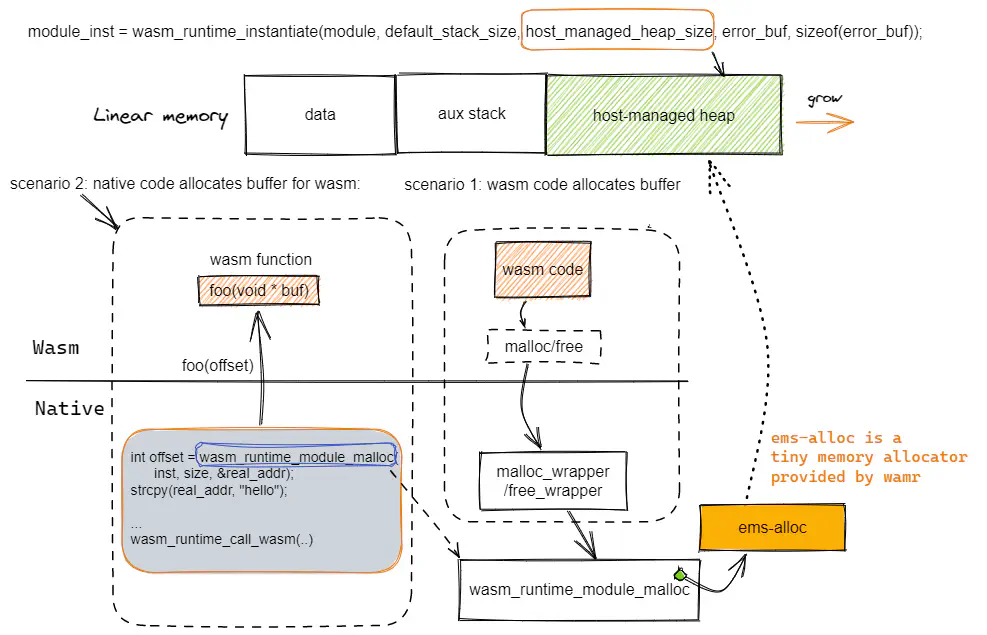Understand the WAMR heaps
Posted in introduction on March 17, 2023 by Xin Wang and Wenyong Huang ‐ 3 min read
Linear memory
The linear memory is a contiguous, mutable array of raw bytes. For most compilers, e.g. wasi-sdk, emsdk, rustc or asc, normally it includes three parts, data area, auxiliary stack area and heap area. The initial and maximum sizes of linear memory can be configured through the compilation parameters:
- For wasi-sdk, the initial/max size can be specified with -Wl,–initial-memory=n1,–max-memory=n2
- For emsdk, the initial/max size can be specified with -s INITIAL_MEMORY=n1 -s MAXIMUM_MEMORY=n2 -s ALLOW_MEMORY_GROWTH=1 or -s TOTAL_MEMORY=n
- For asc, they can be specified with –initialMemory and –maximumMemory flags

Data area: The size is determined by the compiler like wasi-sdk and the its value is provided in the Wasm GLOBAL __data_end.
Aux stack: For wasi-sdk, the size can be specified with -z stack-size=n, for emsdk, the size can be specified with -s TOTAL_STACK=n
Heap area: The value of heap base address is provided in the Wasm GLOBAL __heap_base by compilers such as emsdk and wasi-sdk.
Note: For embedded environment where we want the linear space can be smaller than 64K, it is recommended to export __heap_base and __data_end. When there are no memory grow opcode in the Wasm module, WAMR will truncate the linear memory into the size indicated by __heap_base, so that the linear memory can be less than 64K.
The Wasm heap and its typical usages
In the most situations, a Wasm instance needs a heap for dynamic memory management. The Wasm heap is located in its own linear memory space.
There are two typical usages of heap:
- Wasm code calls malloc/free on its own heap
- The native code of the host calls
wasm_runtime_module_mallocto allocate buffer from the Wasm app’s heap, and then use it for sharing data between host and Wasm.
WAMR supports two heap types: wasi-heap and host-managed-heap.
WASI-libc heap
Create wasi-heap
If a Wasm module is built with WASI-LIBC, the wasi-heap will be created and managed by the memory allocator provided by the wasi-libc.
Scenario 1: When the Wasm code calls malloc/free, wasi-libc memory allocator will operate on the wasi-heap.
Scenario 2: If the native calls wasm_runtime_module_malloc, it will call the wasi-libc functions malloc/free. Note: this is only supported when the Wasm module exports functions malloc/free.

Host managed heap
When is it needed?
The host-managed-heap (formerly called app-heap) is usually required for either situation below:
- Wasm module requires import of malloc/free (usually caused by app build without WASI, like for embedded)
- Native and Wasm need to share data through buffer but the Wasm module has no
exportof malloc/free for any reason
Create host-managed-heap
The creation of host-managed-heap is done through passing non-zero value to the parameter host_managed_heap_size in the function call of module instantiation as below.
module_inst = wasm_runtime_instantiate(module, default_stack_size,
host_managed_heap_size,
error_buf, sizeof(error_buf));
Working flow
Once the host-managed-heap is created, it will be managed by the ems that is a tiny memory allocator provided by WAMR.
Scenario 1: When the Wasm code call malloc/free, it will go to the imported native functions malloc_wrapper/free_wrapper. These two wrapper functions then calls the malloc/free of ems.
Scenario 2: If the native calls wasm_runtime_module_malloc, it will also call the ems memory allocator to operate the host-managed-heap.
Q&A
- Can the wasi-heap and host-managed-heap co-exist?
- yes. When the wasi-libc malloc/free are not exported by wasm module and the default_stack_size parameter is non-zero in calling wasm_runtime_instantiate(), two heaps will co-exist. Then the scenario #1 will go the wasi-heap and the scenario #2 will go the host-managed-heap.



